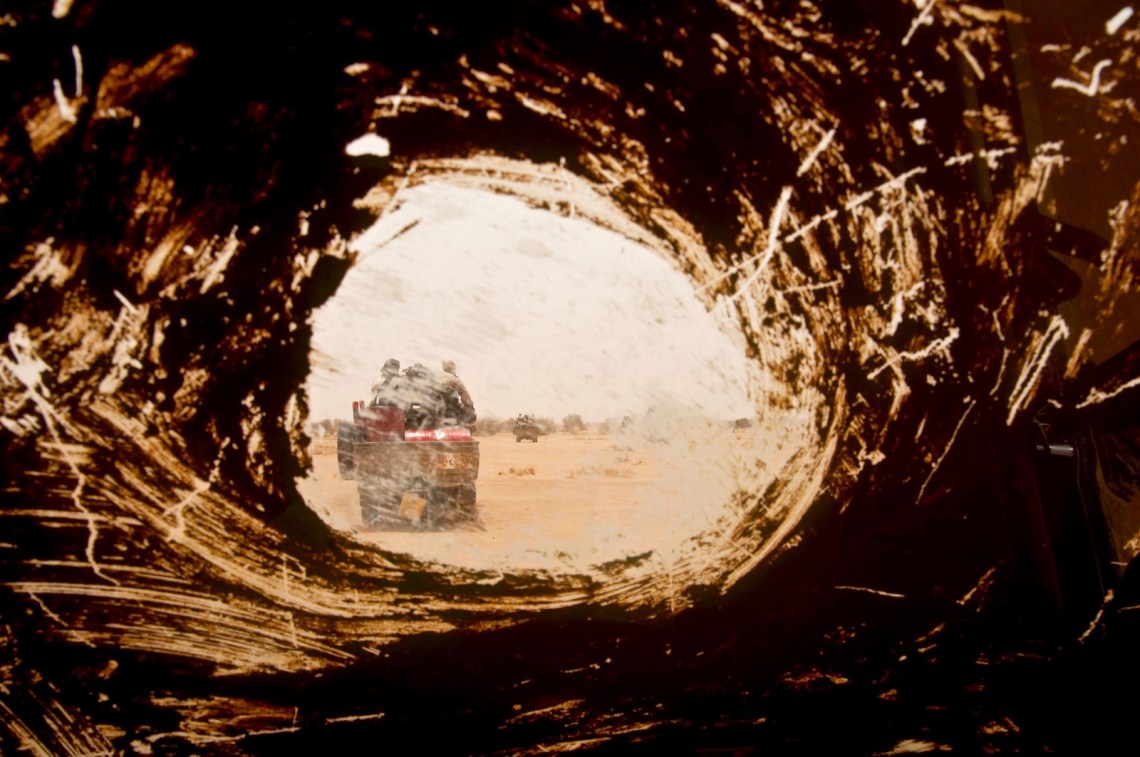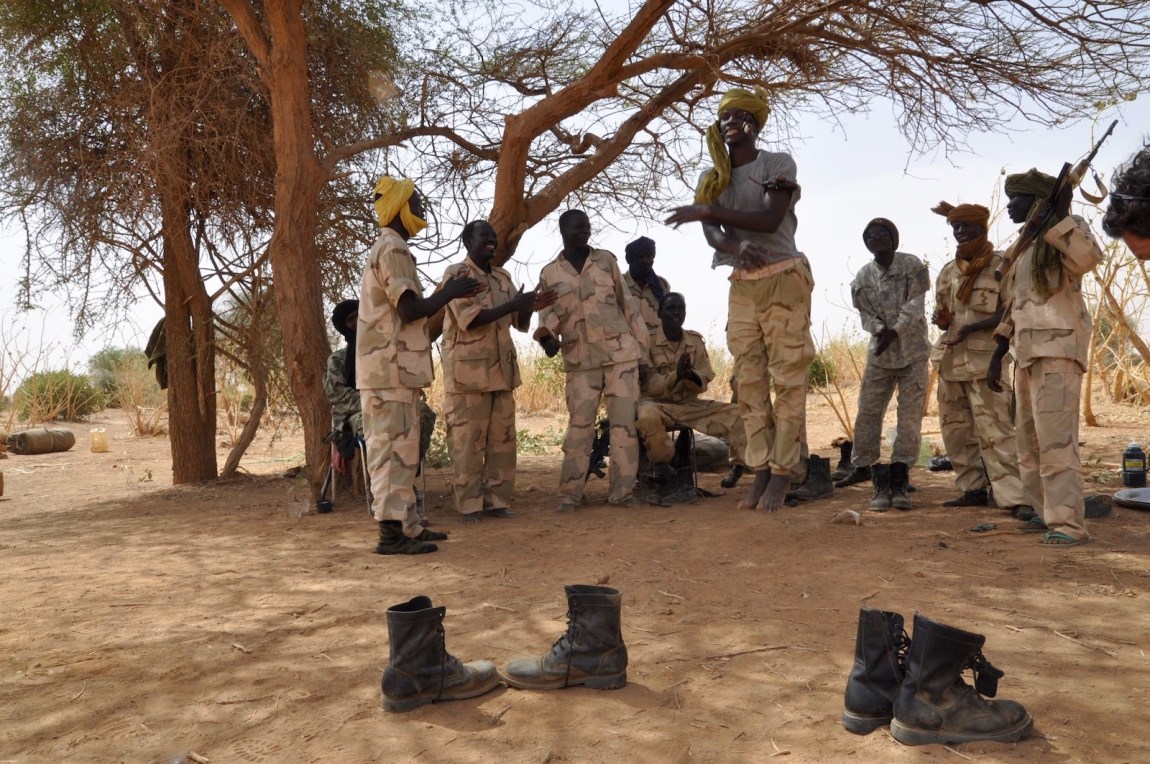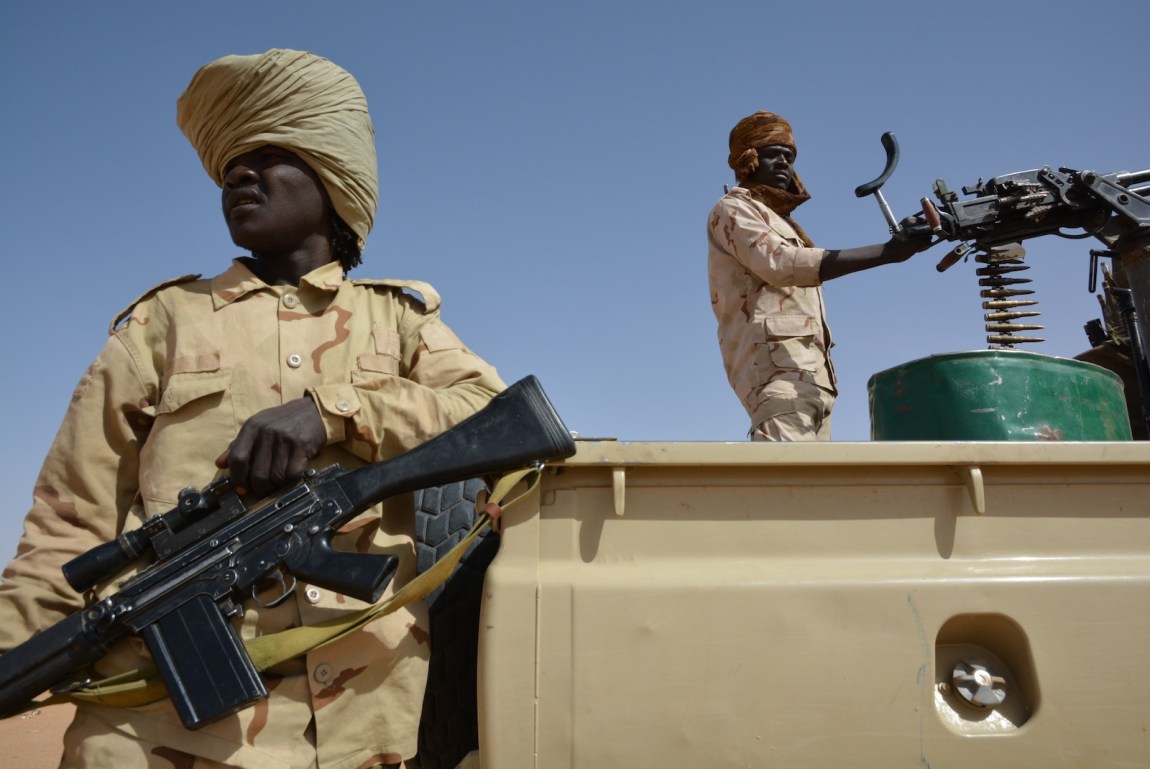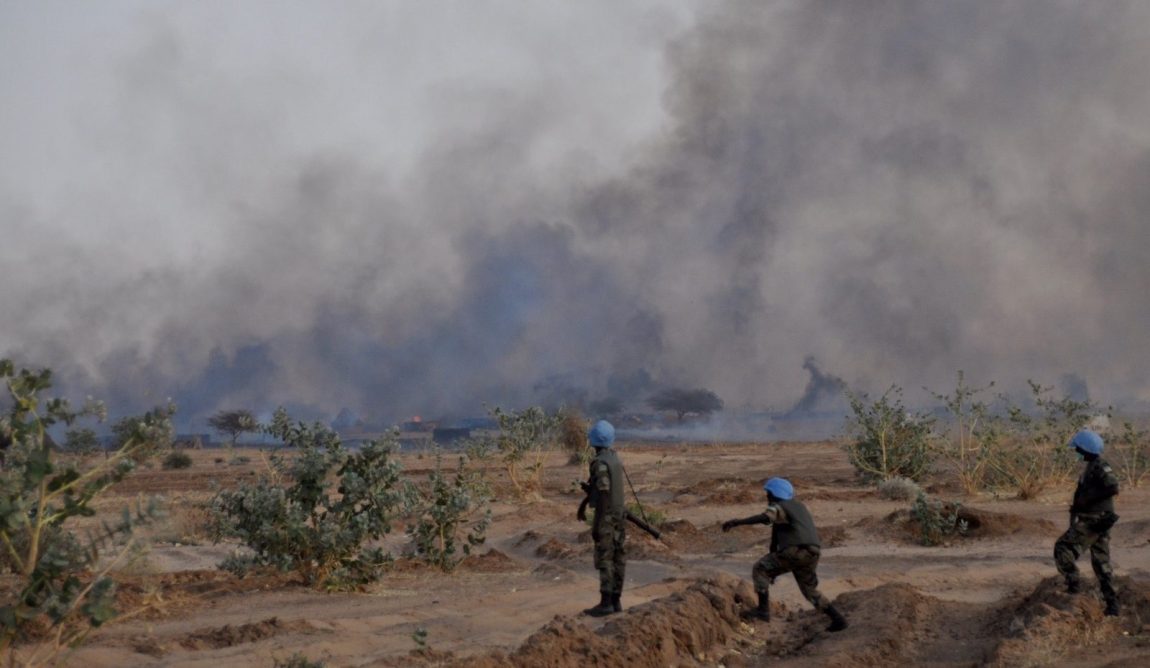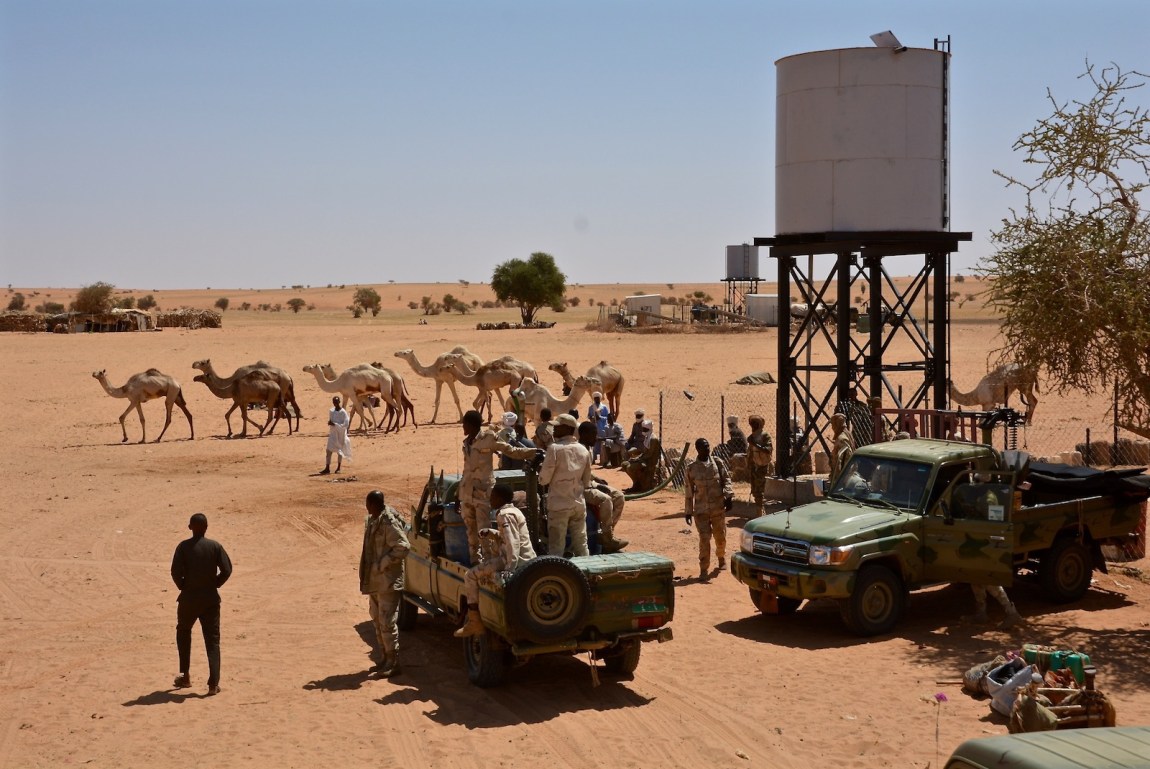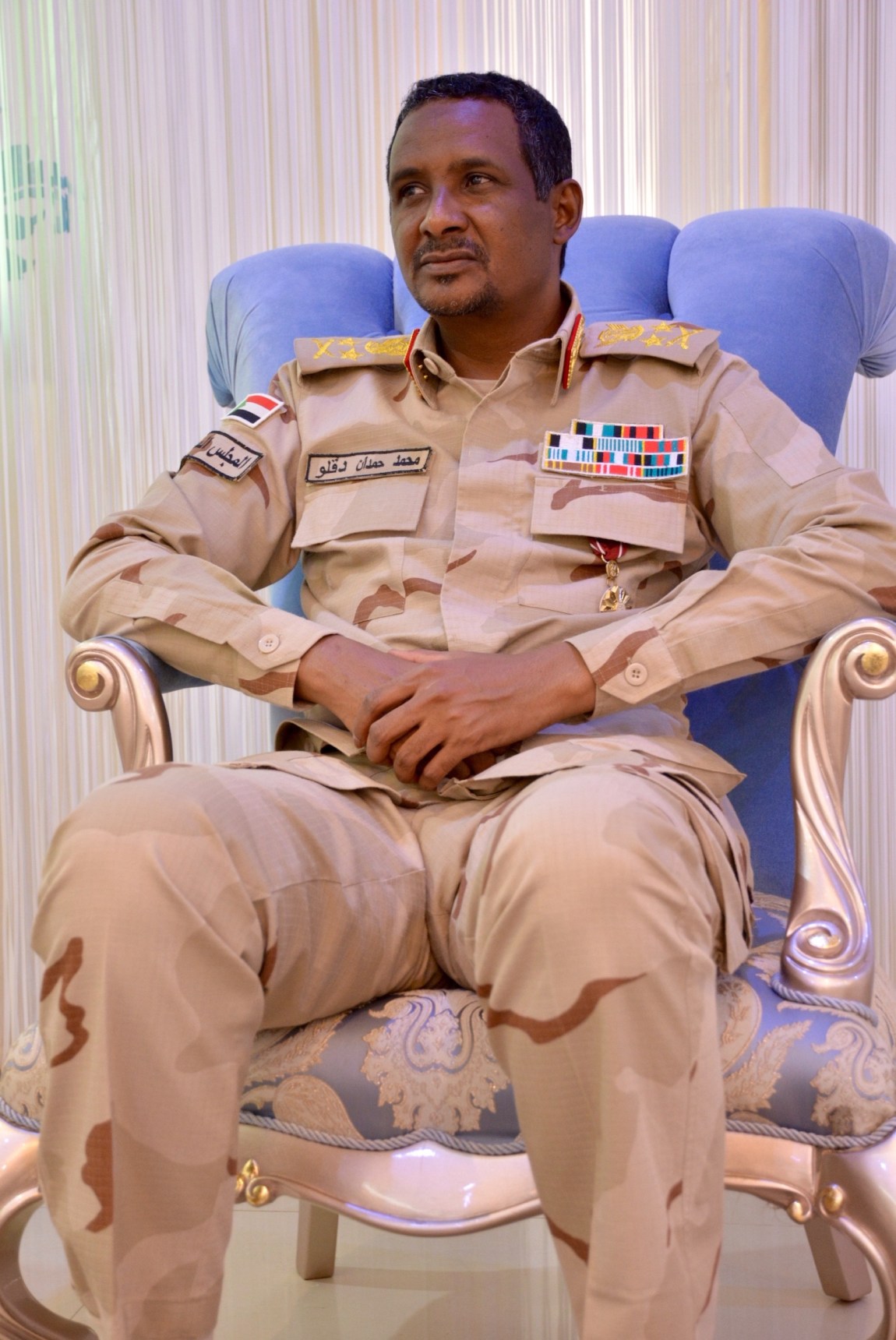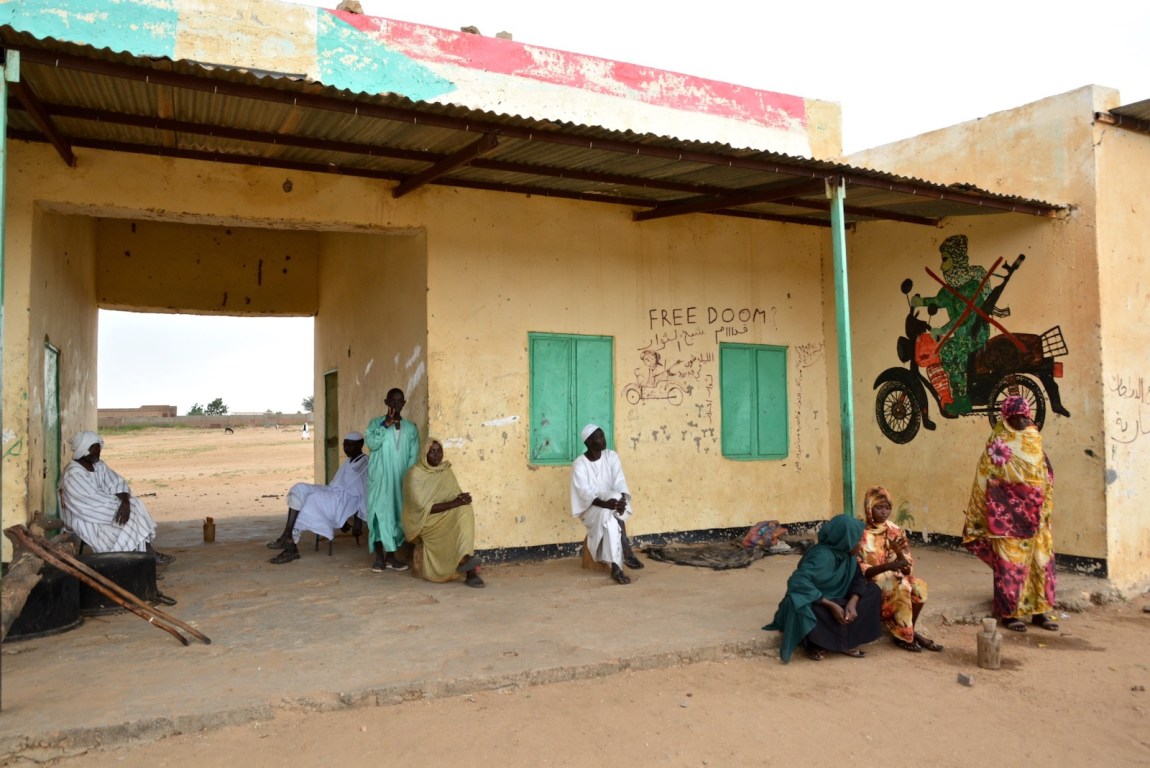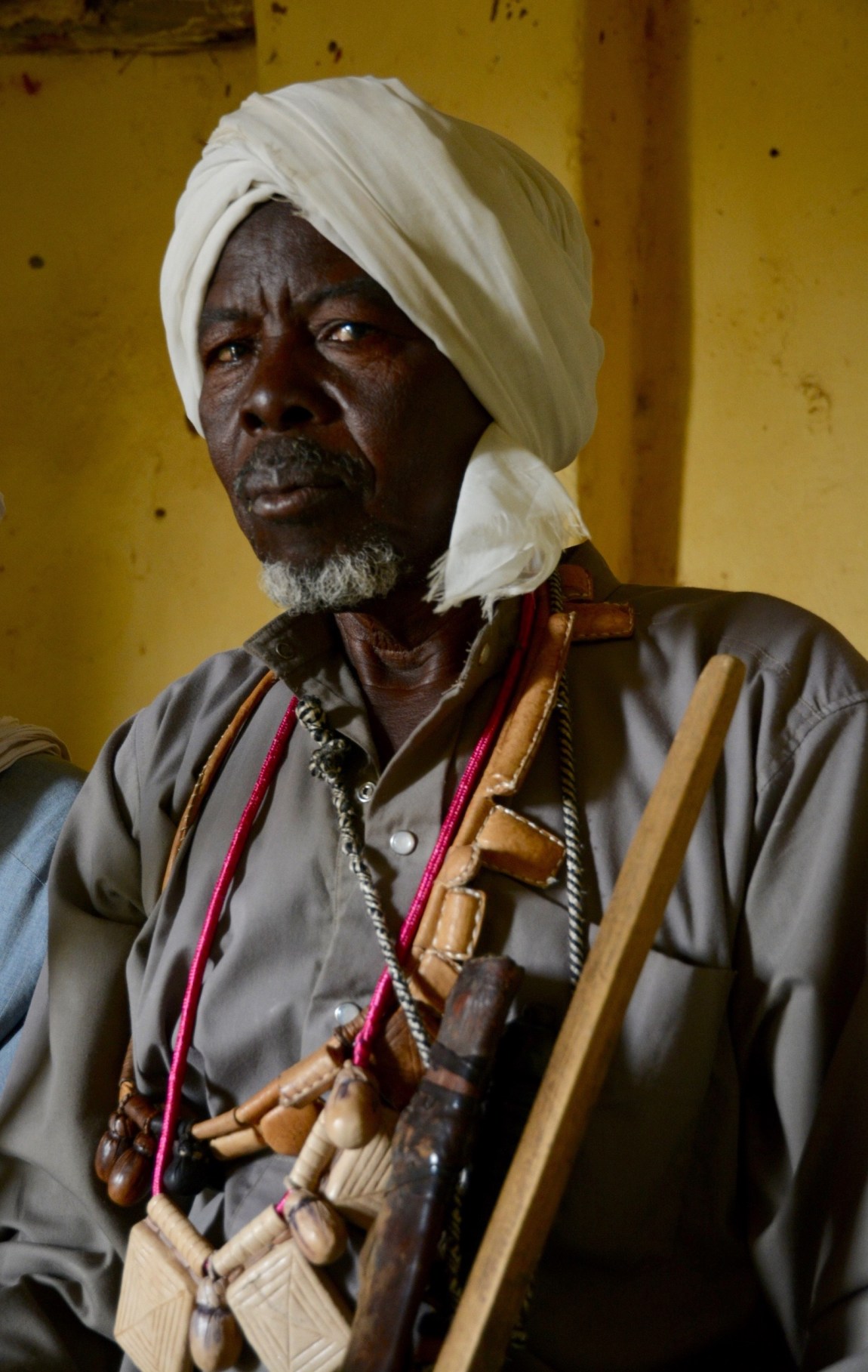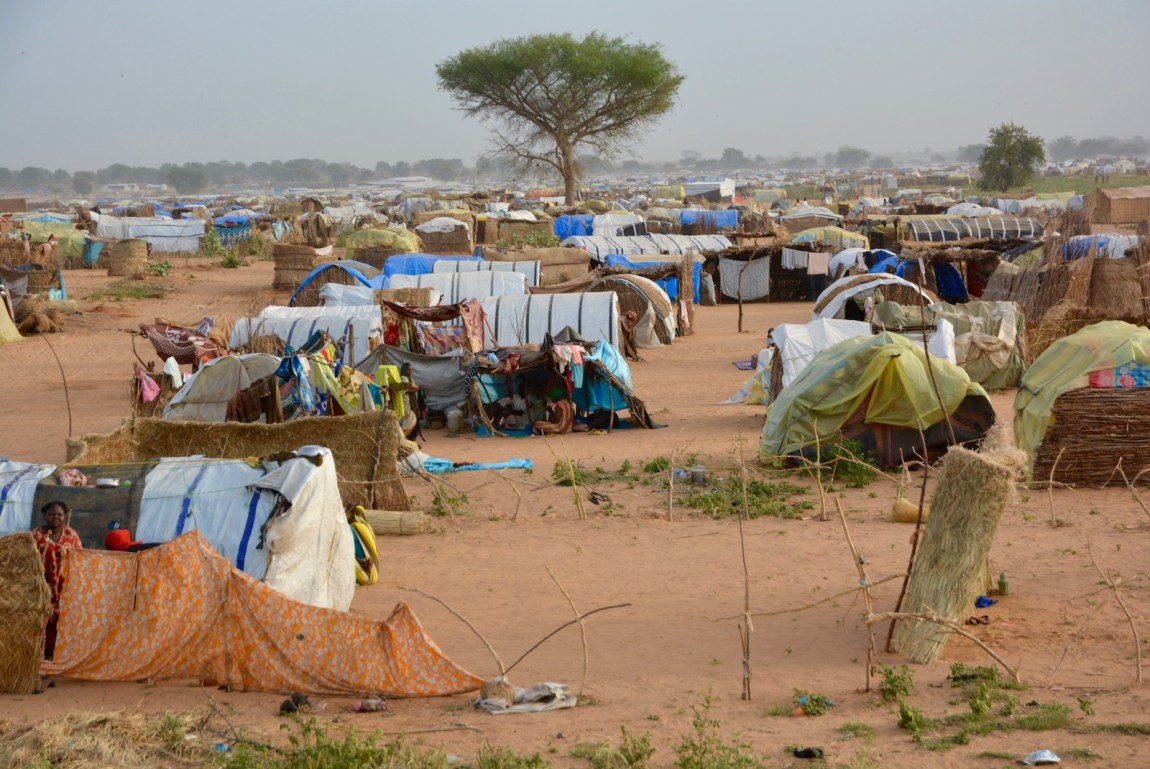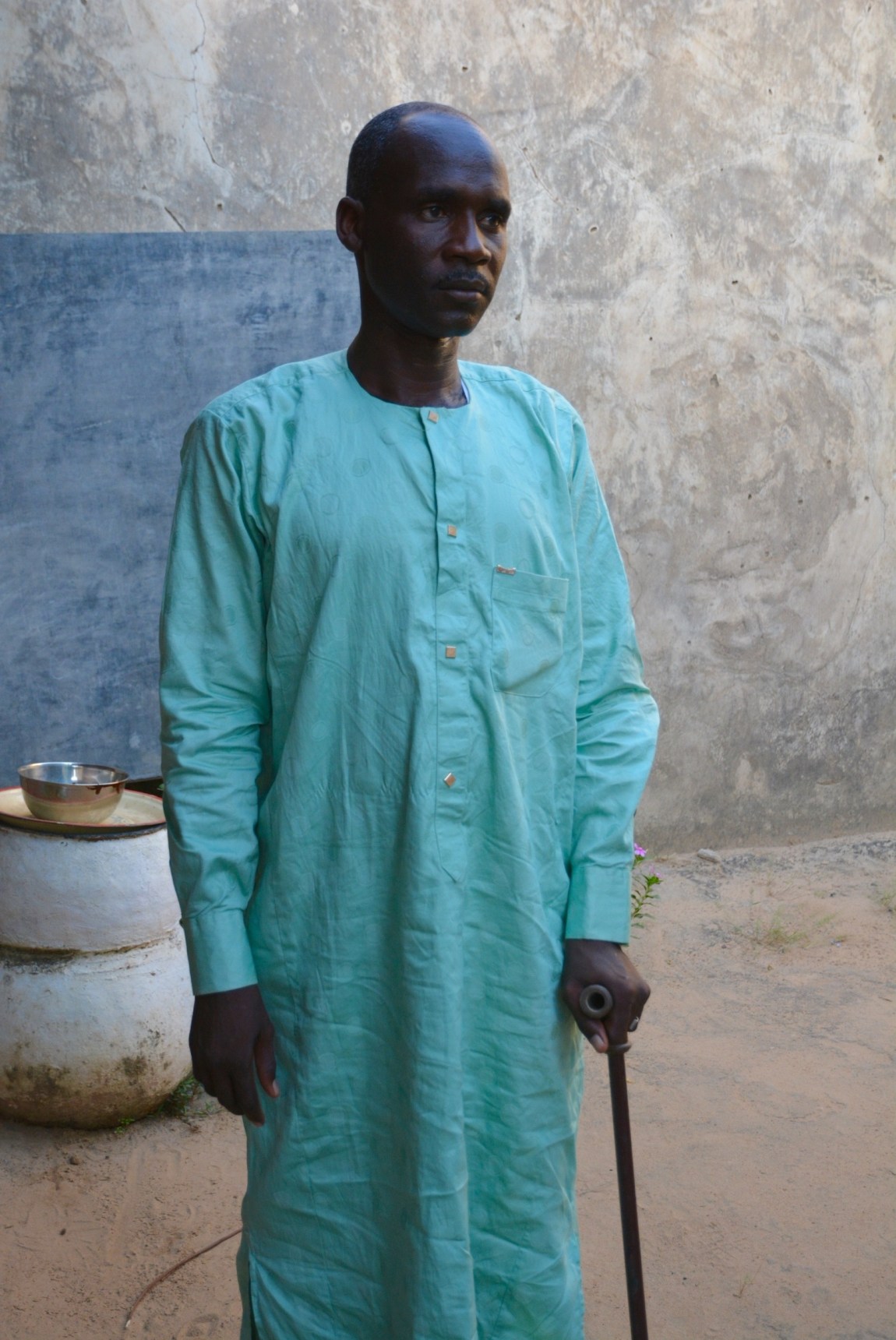In 2009 Arbab, a tall, slim, thirty-five-year-old man, was driving a pickup truck in North Darfur province, part of a rebel convoy that had crossed into Sudan from Chad. Aside from a small circle in the windshield through which to see the road, his vehicle was covered in mud, making for a stark contrast with his perfectly clean uniform. The guerillas were trying to hide from the Sudan Armed Forces (SAF), whose fighter jets nonetheless launched optimistic volleys at their convoy.
The conflict in Darfur, a region the size of France in the west of Sudan, had begun in 2003. It pitted two rebel forces, largely drawn from local non-Arab communities, against the central government of President Omar al-Bashir. Rather than relying on the army alone to deal with an uprising in a remote area, Bashir formed the Janjaweed (“devil horsemen”) militias, largely comprised of Darfuri Arabs, which laid waste to the region and attacked non-Arab civilians as part of a campaign of ethnic cleansing. A common estimate for casualties is 400,000, but this counts only the most violent period, from 2003 to 2005, and the war never really stopped.
By the time Arbab’s convoy entered Darfur, the International Criminal Court had issued an arrest warrant against Bashir for crimes against humanity in the region (a charge of genocide was added later). A joint United Nations–African Union (UN–AU) peacekeeping force was deployed, to little effect. Yet the situation was not entirely hopeless. The SAF seldom left their barracks and the Janjaweed rarely ventured into North Darfur’s rebel zones. Some of Darfur’s Arabs were growing disenchanted with Bashir’s regime; a handful of university students had even joined the uprising.
That year, one of us, Jérôme, interviewed Arbab and his comrades, who hailed from the Masalit, a non-Arab community indigenous to Darfur. They described how Janjaweed militias had razed their villages and occupied their land. Some wiped away tears as they spoke. Then they spontaneously performed their villages’ dances, in remembrance of a lost way of life.
*
Fourteen years later, this past October, Jérôme met Arbab again at a surgical hospital run by Médecins Sans Frontières (MSF) in Adré, a dusty town in Chad, near the border with Sudan. Looking at pictures of those dancers, Arbab said that all but one were dead. Some had been killed fighting the Sudanese government, others as mercenaries in Libya, and one more recently, in a battle against Arab militias in West Darfur’s capital, El-Geneina, during which Arbab himself was shot in both legs. He now used crutches.
The clashes in El-Geneina are part of a new conflict that began last year on April 15, pitting the SAF against one of its former proxies: the Rapid Support Forces (RSF), a rebranded version of the Janjaweed. This is the first civil war to be waged in Sudan’s capital, Khartoum, where the belligerents are focused on taking state power. Yet fighting has spread across the country and thousands of civilians have been killed, largely because of indiscriminate shooting and bombing by both parties; almost eight million have been displaced. The violence has been especially intense in West Darfur, where tensions between Arabs and the Masalit were already high following reciprocal murders last March.
In April the RSF attacked a SAF convoy in El-Geneina, detonating local conflict. Arab militias allied with the RSF looted the city’s market with the help of civilians. (Some traders pillaged their own shops alongside the militias, seeing it as the only way to keep their property.) Arab forces also shelled Masalit neighborhoods and IDP (Internally Displaced People) camps. When the SAF did not protect civilians, Masalit self-defense and rebel forces entered the fight. “We couldn’t leave our people,” Arbab said. By early May hundreds had been killed, their bodies buried in mass graves at night to avoid sniper fire.
Later that month, SAF soldiers from the Masalit community finally left their posts to fight alongside their kinsmen. This spurred the mobilization of further Arab forces, which were later assisted by RSF reinforcements from Khartoum. By mid-June the Masalit had to abandon most of El-Geneina to the Arab militias, except for the neighborhood of Ardamata, around the SAF garrison. Things were quiet until November, when the RSF and its allied militias captured Ardamata, again with little resistance from the army, and again killed Masalit civilians en masse. According to a recent leaked report by UN sanctions monitors, between 10,000 and 15,000 people have been killed in El-Geneina since April 15, roughly as many as the UN estimates for the whole of the rest of the country.
In all around 550,000 refugees, most of them Masalit, have escaped to Chad. Many were shot as they fled. Last June 1,028 war-wounded were admitted to the MSF hospital in Adré in a single week. The two-hundred-bed facility was made up of a stockade of white rectangular tents hemmed in by thousands of makeshift shelters, which are now the homes of some 100,000 new refugees. It has struggled to cope with the arrival of the injured, many in need of surgery.
Advertisement
In November MSF released a retrospective mortality survey, made in the new refugee camps of eastern Chad. It found that in the Ourang camp, where most were from El-Geneina, the death rate was twenty times higher after the onset of the fighting. Of the dead, 83 percent were male—a statistic consistent with accounts from refugees, who made clear that Arab forces had accused Masalit men and boys of being combatants and targeted them as such. Twenty years ago, similar studies informed the US government’s decision to label Bashir’s counterinsurgency operations in Darfur a genocide.
“What happened is a project,” a Masalit chief of a deserted IDP camp told Jérôme this past October. “First we were forced from our villages to IDP camps, then from IDP camps to gathering sites”—public buildings in El-Geneina where about 100,000 displaced people found shelter in 2021—“and finally from gathering sites to refugee camps. It’s a project that’s been planned for a long time, and now they are implementing it and taking our land.”
*
Since independence in 1956, an Arab elite in Khartoum and its satellite cities has monopolized power in Sudan, leaving the rural hinterlands underdeveloped while drawing on their resources and cheap labor. The country’s ethnically diverse peripheries have long had limited representation in government, no matter which political or military group holds control. In two civil wars, the first between 1956 and 1972 and the second between 1983 and 2005, rebel groups, largely from southern provinces, took on successive governments in Khartoum; the second war culminated in a peace process that led to the secession of South Sudan.
The Sudanese government rarely fights its civil wars with just the national army. It also sponsors local militia forces. In southern Sudan, it set the region’s two largest ethnic groups, the Dinka and Nuer, against each other. In Darfur, it favored nomadic Arab herders over sedentary non-Arab farmers. Many Arabs had moved to West Darfur in part due to droughts in their traditional homelands in northern Darfur and Chad in the 1970s and 1980s; they clashed over territory with the Masalit, whose ancestors once ruled over a powerful pre-colonial sultanate.
Bashir sided with the nomads because the Masalit were close to the political opposition as well as to rebel groups. In 1994 he gave nine Arab chiefs the title of emir, allowing them to allocate territory, challenging the traditional Masalit authorities. Arbab, then a twenty-year-old student, enlisted in a Masalit self-defense militia that year; two years later, he took an oath on the Koran and received his first gun—an old rifle. He was soon made the chief of operations to a senior Masalit commander, Khamis Abbakar.
The communities remained evenly matched in low-intensity conflict until 1999, when Bashir sent a trusted general, Mohamed al-Dabi, as his envoy to El-Geneina. (His office manager was a young major called Abdelfattah al-Burhan—now the commander of the SAF.) Dabi proved effective. Only a few months after his arrival, Arbab and Khamis were arrested and jailed for two and four years, respectively.
By 2003 the non-Arab groups had come to realize that they would have to take on Bashir’s regime, not just the local Arab forces, and that to do so they would need to unite militarily. That April the two initial rebel movements—with only thirteen pickup trucks and 317 fighters between them—destroyed two SAF planes and five helicopters at the airport of El-Fasher, the capital of North Darfur.
The government reacted badly to that humiliation. SAF planes bombed non-Arab villages and then the Janjaweed invaded them, often accompanied by regular soldiers. They killed men as suspected rebels, raped women, looted livestock and houses, and razed villages to the ground. Between 2003 and 2005 some two million Darfuris were displaced. But that didn’t stop the rebellion. On the contrary, it grew dramatically in size, from a few dozen recruits to thousands, many of them young survivors thirsting for revenge.
Masalit self-defense forces were among the first to join the rebellion, but they had a limited role in the leadership and were easily defeated in West Darfur. Those who did not return to civilian life thereafter joined rebel factions elsewhere in the region. Much of the Masalit community fled, either to IDP camps around El-Geneina or across the border to Chad. Those who remained had to accept the dominion of Arab militias on their land. In the late 2000s and the 2010s, while the rest of the region was at war, West Darfur seemed relatively tranquil, but it was the peace of victors.
Advertisement
Bashir’s control of the Janjaweed was never absolute. He had given them free rein to rape and kill and loot and take land, and provided them with plenty of weapons. But many grew dissatisfied with being proxies; they demanded better salaries, integration into regular armed forces, and schools and hospitals for their communities.
For his part, Bashir was worried about the prospect of a palace coup from within the ranks of his security services. In 2013 he addressed the two problems at once by formalizing some of the Janjaweed militias and christening them the RSF, complete with uniforms, salaries, and a formal command structure. This force became Bashir’s praetorian guard, protecting him from his generals. Initially the RSF only had six thousand fighters, but it rapidly grew. Estimates for its current fighting strength vary wildly, but various RSF sources cited a payroll of 200,000 immediately before the current conflict, at a time when the group was in the process of recruiting 100,000 more men.
Bashir handed control of the RSF to Mohamed Hamdan Daglo, otherwise known as Hemetti. A young Darfuri Arab commander, he had proved more reliable than the older Janjaweed leaders, except for leading a six-month mutiny back in 2007. Hemetti was also more successful, inflicting a series of losses on the Darfuri rebel groups between 2015 and 2017. The defeated guerillas took refuge in South Sudan and Libya, where Arbab fought as a mercenary for the Libyan strongman Khalifa Haftar between 2015 and 2021.
Few among Khartoum’s elite were happy about Hemetti’s rise. Uneducated, a former camel trader, and from the peripheral Mahariya tribe, he was a parvenu among the coterie of families that had long ruled Sudan. There were also material interests at stake: Hemetti had invested his growing political capital in various business ventures through a family holding company, Al-Jineid. He holds extensive assets in the booming Sudanese gold sector, which were strengthed after the RSF took control of the Jebel Amir mine in 2017. Much of this gold is exported to the United Arab Emirates, Hemetti’s principal foreign backer. His growing wealth challenged Sudan’s established patronage networks, including that of the army, which has its own business empire that includes factories, banking, farming, and real estate.
*
Bashir sat atop a set of rivalrous security services as their patron-in-chief, wheeling and dealing his way through a thirty-year-long dictatorship. But even he could not negotiate his way out of the protests that broke out in 2018, amid an economic crisis prompted by an acute shortage of foreign currency reserves. Demonstrations began in the peripheries, including in El-Geneina, but soon they came to Khartoum and brought the capital to a halt. On April 11, 2019, senior officers, fearing for their future, deposed Bashir; Hemetti took a leading role in the autogolpe. Bashir’s ejection, however, was not enough for the protesters, who maintained a sit-in just in front of the military’s headquarters.
The demonstrations were led by resistance committees: acephalous groupings, sorted by neighborhood, which organized mutual aid and political action. The army and the RSF violently cleared the sit-in on June 3. By the end of the day, at least 128 protesters were dead. After the massacre, with international pressure mounting, an agreement was signed in August 2019 that led to a transitional government. A civilian coalition, the Forces of Freedom and Change, shared power with the military. Still, Burhan had been appointed president, Hemetti vice-president, and the army often blocked attempts at civilian governance. Over the next three years alliances shifted between and within the civilian and military camps.
This was Hemetti’s arrival on the political stage. Since then, he has awkwardly tried to play three roles at once: an entrepreneur who oversees a transnational business; a military leader who heads a war machine involved in widespread looting; and a politician seeking acceptance at home and abroad, including by drawing close to Sudan’s civilian politicians and sending troops to Yemen under the Saudi-led coalition fighting the Houthis. These roles have often been at cross purposes, but he cannot abandon any of them. Without his military, his business goes broke; without political clout, he cannot maintain his army; without money, he risks losing friends.
At first Hemetti tried to look beyond Darfur and position himself as a national leader. He claimed that the RSF was a genuinely multiethnic force, unlike the sclerotic elite running the Sudanese army. (In truth, the RSF has remained a family affair: Hemetti’s relatives occupy its upper echelons.) He tried to turn weaknesses into strengths, presenting his lack of education, mocked by the elite, as evidence that he was the populist leader of a new generation. But this convinced neither Khartoum’s protesters nor its politicians.
Rejected at the center, Hemetti tried to reconcile with his erstwhile enemies, the Darfuri rebel groups. The negotiations that created the transitional government had neglected talks with Sudan’s peripheries, including Darfur, South Kordofan, and Blue Nile, which might have given rebel movements there a reason to make peace. This offered Hemetti an opportunity. He led informal talks with guerillas, hoping to create a unified Darfuri bloc that would challenge the civilian and military elite in Khartoum. In October 2020 six opposition groups or coalitions signed the Juba Peace Agreement (JPA), a power-sharing treaty that brought some of them into the government.
Yet the JPA failed to produce the unified Darfuri bloc that Hemetti had hoped for. Instead the rebels each went their own way: some struck deals with the military, while others forged alliances with parts of the fragmenting civilian coalition. Nor did all Darfuri Arabs welcome Hemetti’s strategy. Leaders in El-Geneina, especially, had benefited from Bashir’s patronage and looked back nostalgically to his regime and the original Janjaweed leader, Musa Hilal—Hemetti’s rival, jailed between 2017 and 2021 by the RSF. They resented Hemetti for negotiating with their enemies and worried about Masalit claims to a right of return. For their part, Darfuri resistance committees merged the pro-democracy chants of Khartoum-based activists with local demands for justice and land rights.
The situation in West Darfur was especially fraught. Shortly after Bashir’s fall, Masalit leaders, some of them former rebels, had restarted self-defense forces, sensing an opening to reclaim their land. Arab militias, including members of the RSF, responded by attacking Masalit villages and IDP camps, culminating in an assault on the Kirinding camp in January 2021 that displaced 50,000 people into El-Geneina. (Two weeks before the assault, the UN-AU peacekeeping mission in Darfur began its long-planned shutdown, having concluded that the region was finally at peace.)
In the aftermath of the attack, in a grim inversion of the protests that brought down Bashir, an “Arab sit-in” was organized in El-Geneina, demanding the eviction of the Masalit camps around the city. Local Arabs were further exercised in June 2021, when Khamis Abbakar was appointed the governor of West Darfur as part of the JPA. The agreement also allowed signatory rebel groups to join new security forces, which would in theory replace the departed UN peacekeepers. With few soldiers of his own, Khamis called upon his old guerilla troops and Masalit self-defense forces; Arbab brought eleven armed pickups from Libya.
*
His plans in Darfur foiled, Hemetti found himself isolated. In late 2020 he told Jérôme that he was the central figure in Sudanese politics, but also “a target for both the left and the right.” By “the left” he meant the civilian politicians, from the communists to the religious Umma party. The “right” referred to the Islamists and members of Bashir’s former regime, some of whom were still active in the military. Rhetorically attacked from both sides, Hemetti thought it easier to turn first against the unarmed left. In October 2021 he and Burhan united in deposing the civilian prime minister, Abdalla Hamdok, in a coup supported by half of the Darfuri rebel groups that had signed the JPA. For a moment, it seemed as if civilians were once again up against a unified military establishment.
But the coup did not usher in a successful military regime. It never found a civilian figurehead who could be blamed for the country’s economic woes; there was also growing international pressure for a new deal between the military and the civilian opposition. In December 2022 the two parties signed the Framework Agreement, a nebulous document intended to pave the way for a civilian-led government. Hemetti took his chance to backtrack from the coup, which he publicly declared a mistake, while pivoting toward the politicians he had so recently ousted, many of whom welcomed the rapprochement; the RSF, they thought, could provide the military force they sorely lacked.
Burhan and Hemetti were thus set against each other in a zero-sum competition. The Forces of Freedom and Change edged closer to Hemetti, while some Darfuri rebel groups—worried about the status of the JPA, which guaranteed their place in government—threw their lot in with Burhan. To make matters worse, the Framework Agreement left an absurdly short timeframe for negotiations: the complicated question of security sector reform, including the incorporation of the RSF into a national army, was supposed to be resolved in just a few weeks. In March 2023 Burhan expelled RSF representatives from a meeting on the issue, after which Hemetti built up his forces around Khartoum. War broke out the following month.
Within days the RSF gained the upper hand in the capital, where it reverted to many of the habits it had learned in Darfur and other peripheral regions: extorting people at checkpoints, looting, and installing fighters in the homes of those who had fled or been killed. The UN claimed to be taken by surprise, but RSF members have long warned that the next war would be between them and the army, and that it would take place not in Darfur but in Khartoum.
*
Most Darfuris, both Arab and non-Arab, likely hoped the war would stay in Khartoum, but it quickly spread west. The RSF took control of transport corridors from the east and starved the SAF garrisons west of the Nile of material and supplies, while benefitting from supply lines running through Chad, Libya, the Central African Republic, and South Sudan. Those routes provided anti-aircraft weapons, drones, and heavy artillery, much of it likely from the UAE. Almost all the main cities in Darfur fell to the RSF by November, including El-Geneina, Nyala, Zalingei, and Ed-Da’ein. In each, residents reported extensive looting and the destruction of humanitarian resources and state institutions. In most cases, the SAF did not so much lose battles as fade away, negotiating with their former allies.
The RSF’s assaults on cities in east, central, and south Darfur have all been defined by extreme violence, but none have remotely matched the levels of ethnic killing in El-Geneina. In March, even as it was clear that a war was about to begin, the UN mission delivered twenty-five vehicles for joint security forces in the city, which included the RSF, the SAF, and Khamis’s men. An attempt by the SAF to commandeer those cars proved the spark that set West Darfur on fire. After initial clashes, the SAF forces, led by officers from central Sudan, largely remained in their barracks, while the RSF, aided by Arab militias, attacked Masalit neighbhorhoods, reportedly with lists of members of the elite, such as lawyers and intellectuals.
Khamis Abbakar’s name was likely at the top. On June 14, after nearly two months of fighting, the governor accused the RSF of genocide in an interview with Saudi television. Khamis was arrested the same day. A video recorded at the scene shows him being taken into the office of the RSF’s West Darfur sector commander, Abderrahman Juma’. A few hours later, images of his battered corpse began to circulate on social media. It was a signal of Masalit defeat, after which the population fled. Khamis’s deputy, Tijani Karshom—an Arab who had fought alongside Arbab back in 2009—was installed as the acting governor. He called for reconciliation and Hemetti released a statement condemning Khamis’s assassination, but the RSF’s ongoing attacks on the ground mocked their commitment to peace.
By November Ardamata was the last Masalit stronghold left in El-Geneina. Civilians and fighters had taken refuge around the SAF garrison. The RSF used drones to attack the SAF forces before assaulting the Masalit civilians living around the military base. Survivors interviewed by Reuters report seeing Masalit men rounded up and shot, or else hacked to death with axes; sexual violence was also recorded, and likely underreported. As in other urban areas that RSF has captured, the neighborhood was looted and dwellings were razed.
Violence on this scale in West Darfur might help satisfy local Arab militias, but it hinders Hemetti’s national ambitions. Ethnic killings under his watch has antagonized Darfuri non-Arabs as well as civilians in Khartoum, and triggered international condemnation, including US sanctions. As Bashir had done in 2003, the RSF has denied what happened or blamed it on forces outside their control, which in turns raises questions about whether one can even speak about Hemetti’s army as a single entity.
Much of the media coverage of the war has turned it into the fight between “two generals.” But the RSF has heavily recruited from local militias over which Hemetti does not have total control. They have looted cities and resold the spoils at so-called “Daglo” markets: stolen goods emporiums, named after Hemetti’s family, that have sprung up across the country. In El-Geneina, militia forces used RSF logistical support and material to pursue their own agendas, settling old scores.
Some of the forces fighting on the RSF’s behalf have inherited the Janjaweed’s Arab supremacist agenda. Across Darfur, even Arabs who once opposed Hemetti and backed Musa Hilal are showing an unprecedented level of support for the RSF. Only North Darfur has been relatively peaceful, thanks to rebel groups that hold El-Fasher. When the RSF threatened to attack the city, those groups mobilized thousands of non-Arab combatants, both inside and outside the country, in a show of unity not seen since 2003. Faced with resistance in El-Fasher, the RSF shifted the war’s epicenter east. In December they overran the capital of Jezira state, Wad Madani, and now they are preparing to launch offensives into White Nile and Sennar states, Sudan’s breadbaskets in the southeast.
Meanwhile, Darfur is largely cut off from the outside world. In a camp called Zamzam, home to about 400,000 displaced people at the gate of El-Fasher, a MSF survey from January found a rate of 2.5 deaths per 10,000 people each day, far above the emergency threshold (one per 10,000), largely because of health issues. Among the causes of death is severe acute malnutrition, which afflicts over 7 percent of children under five (the emergency threshold is two).
The suffering inflicted on Darfur will not heal quickly. “Khamis was fighting,” Arbab said in October, “but what about innocent women and children? Thousands of them were killed. We were targeted for our race. We can’t live together with those people targeting us.”


